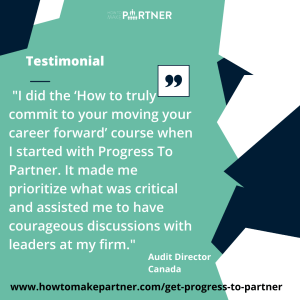How to move from director to partner at a Big 4 firm (EY, Deloitte, KPMG and PwC)
Do you want to know how to get a promotion to partner in a Big 4? How to move from director to partner level? Making partner at a Big 4 accounting or consulting firm (EY, Deloitte, KPMG and PwC) is often seen as the pinnacle of achievement for an Accountant or Consultant. Over the last few years, the Big 4 firms have started to introduce a step between director and partner as part of their Partnership Track. For example, EY’s Associate Partner or Executive Director roles, and KPMG’s Managing Director Role.
.Regardless of the many steps between Director and Partner on your Partner Track in your Big 4 firm, many talented professionals fail to make it. To help you jump from director to partner, here are 9 secrets straight from directors who have made it through the partnership track at their Big 4 firm.
Make a start on your career development and sign up to receive my weekly tips here . You’ll find out what you need to be working on as well as how to make the time for your career development, so that you can progress your career in your firm.
1) Get onto the Partnership Track
The Big 4 firms have formal, structured development programmes for their ’emerging leaders’, often called ‘partner track’ or ‘partnership track’. i.e. their senior managers and directors who they believe can make it to partner.
If you are going to transition from director to partner or senior manager to partner, first you need to be seen as partnership potential. Most of the Big 4 firms worldwide will have an ’emerging leader’ or ‘next gen’ or ‘future partner’ or ‘pathway to partner’ type of programme. (These are actual names of the future partners programme used in some of the Big 4 firms around the world.)
You don’t need to be on this programme if you will make it to partner, but it will be much harder if you are not. Sometimes these programmes are a formal part of a Big’s partnership track; other times, they are an accelerator for people to get onto their Big 4 partner track.
How do you get nominated, I hear you ask? While many factors go into the decision, one very important one is that you have to express your interest in the first place. The people who do get on these programmes have normally been talking for a few years with their mentor and sponsoring partner about their partner ambitions, so to be in the pickings, don’t keep your career ambitions private!
Take a step forward to be in control of your own career progression in your firm. Sign up to my weekly tips here and you’ll find out what you need to be working on in your career development (and how to make the time for your career development) to progress your career in your firm..
The more open you can be about how you would like to progress your career in your Big 4 firm, the more opportunities will open up to you. You also need to ensure that there is (a) an agreed-upon business case for someone like you and (b) your numbers justify your inclusion in a programme like this.
Progress to Partner Academy has a great Game Plan called “.Here’s what to do if you need to raise your profile” to help you get noticed for the right reasons and put on Partner Track.
Premium Progress to Partner members also unlock access to our 14 self-study courses including How to become known as the Go-To Expert, Creating A Cast-Iron Business Case for Partner, How to Delegate Like a Pro, How to Lead & Manage a Team and How To Be On Your A-Game Every Day. Join as a Premium member for just £290 for 12 months access today and login to your Dashboard to get started.
The formal partner admissions process for a Big 4 firm can be up to a year in length, with various long and shortlisting of potential future partners carried out 0-3 years before an individual is admitted to the partnership (yes, the partnership track process can really be that long at a Big 4 firm).
It goes without saying that if you want to make partner at a Big 4 firm, you need first to get yourself onto the long lists and then the shortlists. Are you on the long list?
This is a question you need to ask your mentor/partner. If you are not on the long list, you will not make it from director to partner in your firm.
My thoughts on whether Executive Director, Managing Director or ‘Associate Partner’ are worth going for…
Both EY and KPMG have added in an extra role between Director and Partner. In some Big 4 firms, this is an end destination for a person’s career. In other firms, this part of the partner track you need to go through before you can make partner. Before you consider Executive Director vs Partner in your Big 4 firm, or Managing Director vs Partner in your Big 4, you need to find out the intention behind the Executive Director, Associate Partner or Managing Director Role. Is it a career full stop or part of the Partnership Track at your firm? Plus, what are the expectations on you personally?
Will your part of the firm expect that you go for these stepping stone roles, or will they expect you to go straight to partner? In this video, you’ll find my thoughts on whether it is worth avoiding these stepping stones on route to partner, or just aiming to get promoted straight up to partner. This video is just one of 50+ bite-sized videos which are included in Progress To Partner Academy.
2) Prepare for a marathon, not a sprint
When asked ‘how to get a promotion to partner?’ one of the most common answers from successful directors who made partner at a Big 4 firm is that it is more of a marathon than a sprint, and they wish they’d been prepared for that. If you want to partner at a Big 4 firm, you need to be organised and do a little every week to see any progress towards partner.
‘I wish I knew that I needed to pace myself, and not sprint for a few days/a week, then stand still and then sprint again’
Newly promoted Big 4 partner
Your business and personal case does not get built overnight. It takes time and activity outside of your normal day job. The 2-3 years when you transition from director to partner in your Big 4 firm will probably be some of the toughest years you will ever do. Combining high chargeable time targets potentially with a high level of travelling and a need to build your own profile, is a tough ask for most people. No one said it would be easy to make partner at a Big 4 firm!
I created the Progress to Partner Academy subscriber-only site to make this as easy as possible. There are guides, 14 self-study courses, useful videos, and workbooks waiting for you – everything you need to know about how to make partner all in one place! There’s even a course on “how to make the time for business development”.
Take a step forward to be in control of your own career progression in your firm. Sign up to my weekly tips here and you’ll find out what you need to be working on in your career development (and how to make the time for your career development) to progress your career in your firm.
Read:
How to create a daily business development habit even if you are not a natural business developer
How to finally make business development a part of your daily routine
3) Balance your workload
With the need to build a business and personal case for partner AND do your day job, the only way to do this is to balance your workload actively. The best way to do this is by using the 3 Ps:
1- Prioritise: Prioritise your career. Make your own personal development your most important client. After all, it is easy to put your regular client work first.
2- Plan: Plan your internal PR campaign, your personal development, your team’s development, your business development activities…
Importantly plan your time to recharge, it can actually go against you being the first one in and the last one out of the office or being on client’s sites a lot and people not seeing you and not being able to balance your work.
Tara Fennessy, Executive Coach to Big 4 potential partners
3- Pace: Take your plan one step at a time and action it in the right order. It sounds obvious, but putting one foot in front of the other steadily is what gets you to the finishing line. One of the best ways is to have a ONE BIG FOCUS. This is where you focus your career plan on the biggest thing that will move your career forward in the next 90 days.
Then after the 90 days are up, you pick a new ONE BIG FOCUS.
 You’ll love this great course in Progress to Partner called “How to Truly Commit to Moving your Career Forward”. It’s a game-changer and will get you focussed and help you to create the time and space to work a little on your career plan every.single.week.
You’ll love this great course in Progress to Partner called “How to Truly Commit to Moving your Career Forward”. It’s a game-changer and will get you focussed and help you to create the time and space to work a little on your career plan every.single.week.
Premium Progress to Partner members also unlock access to our self-study courses including The Go-To Expert, Creating A Cast-Iron Business Case for Partner, How to Delegate Like a Pro, How to Lead & Manage a Team and How To Be On Your A-Game Every Day. Join as a Premium member today and login to your Dashboard to get started.
Read:
What is more important; your personal or business case for partnership?
How to make time for business development and still have a life outside of work
4) Deliver on your numbers and personal objectives
This is common sense, but if you want to be seen as future partner material and worth investing in, you need to make sure that you routinely achieve your personal objectives and targets. If you have an ‘average’ or ‘poor’ performance rating, you are unlikely to transition from director to partner.
Obviously, hitting your targets should be up there on the priority list, but this can suffer when you are trying to prioritise business development, delegate to and motivate your team, build your personal and business case, win new clients and maintain existing client relationships all whilst keeping your own mental health and physical health intact while you grasp on to a thread of a social life… When you list everything that it takes to make partner (and this isn’t even scraping the surface), you can see why actual work may start to suffer the brunt of being overwhelmed.
Read:
6 clues that you are letting your team members get away with poor performance
12 ways high-performers at the Big 4 avoid burnout AND still hit their targets
13 bulletproof ways highly-successful lawyers win that promotion over their peers
5) Build a strong personal brand internally and externally within the firm
Another big secret from senior managers on how to get a promotion to partner is to build a strong personal brand that’s memorable and to do it as early as possible! Every single business case I have read from a prospective partner in a Big 4 firm mentions their strong brand and how they are the ‘Go-To Expert‘ for some technical specialism in a certain sector.
The Big 4 firms – EY, Deloitte, PwC and KPMG – are all big firms so if you want to stand out enough to make partner, you need to have a strong personal brand and high profile internally and externally of the firm. They suggest the best ways to do this are:
- Specialising earlier rather than later in your career.
- Becoming known as a ‘Go-To Expert’ for some technical or sector-specific knowledge.
- Allocating time every week to building and maintaining a strong professional network. E.g. attending young professional networking events and deepening relationships with other professional advisors you work with.
- Prioritising building your own referral networks which will provide you with a regular stream of high-quality new client leads.
We have a great course in our online Progress to Partner Academy called “How to become the Go-To-Expert“. And our Game Plan called “Here’s what to do if you need to raise your profile” has sections on raising your profile inside your firm as well as externally.
Premium Progress to Partner members also unlock access to our self-study courses including The Go-To Expert, Creating A Cast-Iron Business Case for Partner, How to Delegate Like a Pro, How to Lead & Manage a Team and How To Be On Your A-Game Every Day. Join as a Premium member today and login to your Dashboard to get started.
Read:
Why you need to be a BRAND to progress your career in the professions
What I wish every talented professional knew about personal branding
Is your personal brand blocking your career progression?
6) Start building your Business Case as early as possible
Much like your personal brand, you must start building your business case as early as possible if you want to transition from director to partner. You will find that all Big 4 firms will require potential associate partners, managing directors or executive directors, to have a Business Case.
Take a step forward to be in control of your own career progression in your firm. Sign up to my weekly tips here and you’ll find out what you need to be working on in your career development (and how to make the time for your career development) to progress your career in your firm.
It is widely known that to make partner in a Big 4 accounting firm, you need a strong Business Case. As already mentioned in this article, you will find it hard to get long-listed or put on a future partner development programme if there is not a business case identified for you.
Download our free sample Business Case template here. Use our Business Case template to know what you need to include in your Business Case, the evidence and data you will need. Our template will get your started with your Business Case. No more wondering what to write!
The directors at Big 4 firms, EY, Deloitte, KPMG and PwC, who successfully make it through to partner have been working on their Business Case for at least a few years. It is not impossible, but very hard, to build a strong Business Case within only 12-24 months of actively building a business case for partnership.
One of the most sought-after courses in our Progress to Partner is called “How to Build a Cast-Iron Business Case for Partner”. We think it’s a must-have in your arsenal of tools and guidance to help with your career progression.
Join as a Premium member today and login to your Dashboard to get started.
Read:
4 tested tips which will make your Business Case really stand out (for the right reasons)
Should you consider a ‘quick’ path to partnership by getting promoted to partner at another firm?
This is a difficult question to answer. And you’ll find my thoughts in this video, which is one of the videos included in Progress To Partner.
7) Build your fan base outside of your own department
The partners at a Big 4 firm (EY, KPMG, PwC and Deloitte) will regularly and openly discuss who they will make partner at their Big 4 firm. How many partners would be ‘pitching’ you, and ‘fighting your corner’? To make partner in a Big 4 accounting firm, you will need more than just your sponsor fighting for you! Like a panel-based job interview, you will not be at the table when the final decisions are taken on who should get partnership this time or even get put onto Partner Track. This is why the successful directors who make partner at a Big 4 firm have taken the time to build up a strong fan base within the partnership BEFORE they are considered for admission to the partnership.
Within a strong fan base, there will always be degrees of support. At the lowest level, the successful director will have built enough relationships with partners within their Big 4 firm so that they have a broad base of support for their partnership ambitions. However, successful directors who make partner at their Big 4 firms know that they need to have more than just their head of department and sponsoring partner (who are likely to be the same people) raving about them to the other partners.
Read:
Your top six priorities when you are successful in the partnership admissions vote
How to pick yourself up if you are unsuccessful in the partnership admissions vote
8) Be prepared to relocate
The more mobile you are prepared to be, the greater the opportunity to make partner at a Big 4 firm. What this could mean in practice is you are prepared to relocate your family to a completely different country.
I recently spoke to an EY director who relocated from India to work on his biggest client’s affairs in Africa. This may be slightly more drastic than you may be prepared to do. However, the more flexible you can be with your mobility, the more opportunities available to you to make partner at a Big 4 firm.
9) If necessary change firm
How to get a promotion to partner may take moving firms to speed up your progression through the track.
Whilst it may be nice to say that you are ‘man and boy’ at a firm, the directors who successfully make partner at a Big 4 firm are prepared to change firm if it means they are able to strengthen their business and personal case significantly.
Finally make that jump from director to partner
Now you know how to get a promotion to partner straight from the horse’s mouth! These directors have successfully made it to partner in their Big 4 firms, so if you listen to and implement these 9 areas in your daily work life, you can’t go far wrong.
To unlock 12-months access to my resources (videos, courses, recordings, guides, newsletter) that will guide and show you what you really need to do to get noticed in your firm – join my Progress to Partner online Academy
Premium members also unlock access to our self-study courses including The Go-To Expert, Creating A Cast-Iron Business Case for Partner, How to Delegate Like a Pro, How to Lead & Manage a Team and How To Be On Your A-Game Every Day. Join as a Premium member today and login to your Dashboard to get started.
.








